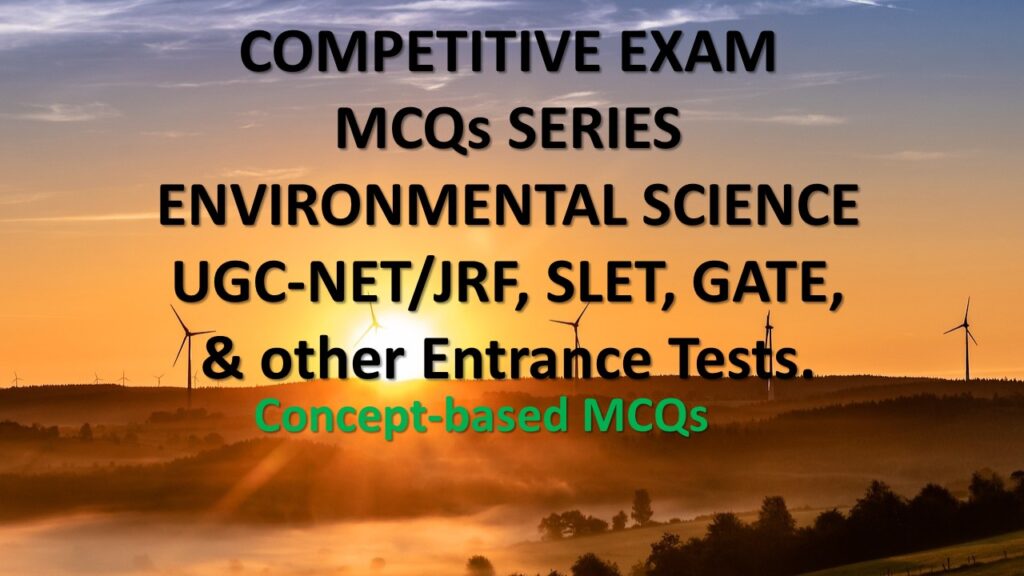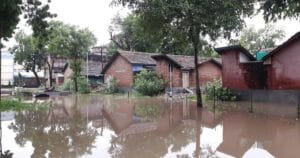
Welcome to the COMPETITIVE EXAM MCQs SERIES of ENVIRONMENTAL SCIENCE for UGC-NET/JRF, SLET, GATE, and other entrance tests – Laws of Thermodynamics.
Syllabus outline
- Definition and scope of thermodynamics in the context of environmental science.
- Zeroth Law of Thermodynamics – Concept of thermal equilibrium, temperature measurement and scales.
- First Law of Thermodynamics (Conservation of Energy): Internal energy, work, and heat.
- Energy transfer processes in closed and open systems.
- Application of the first law to ecological systems.
- Heat transfer mechanisms: conduction, convection, and radiation.
- Work done in mechanical, electrical, and biological systems.
- Second Law of Thermodynamics – Entropy and its significance in energy transformations.
- Entropy changes in reversible and irreversible processes.
- The concept of energy quality and the maximum efficiency of energy conversion.
- Applications of the Carnot cycle in environmental contexts.
- Definition and types of thermodynamic equilibrium.
- Stability criteria and their relevance in environmental systems.
- Ecosystem energetics and energy flow through food webs.
- Thermodynamics of atmospheric processes (e.g., convection, adiabatic cooling).
- Energy considerations in environmental engineering and sustainability.
This quiz contains the concept-based most frequently asked 25 MCQs of “Laws of Thermodynamics“. Each question has a single correct/most appropriate answer.
1. The concept of entropy generation is relevant in environmental science as it quantifies the following:
a) Efficiency of heat transfer in geothermal systems
b) Energy losses in energy storage systems
c) Increase in disorder in ecological systems
d) Dispersal of pollutants in aquatic ecosystems
2. The efficiency of solar panels in converting sunlight into electricity is influenced by:
a) The ambient temperature of the solar panel
b) The intensity of sunlight received
c) The thermal conductivity of the solar panel material
d) The reflectivity of the solar panel surface
3. A solar thermal power plant has a collector area of 10,000 square meters and a solar irradiance of 1000 W/m². If the efficiency of the solar collector is 60%, what is the maximum power output of the plant?
a) 600 kW
b) 600 MW
c) 60 MW
d) 6 MW
4. Assertion (A): The laws of thermodynamics can be used to study energy flow in photosynthesis.
Reasoning (R): Photosynthesis is a process that involves the conversion of solar energy into chemical energy.
a) Both the A and R are true, and the R is the correct explanation of the A.
b) Both the A and R are true, but the R is not the correct explanation of the A.
c) The A is false, but the R is true.
d) The A is true, but the R is false.
5. The entropy of a closed system tends to:
a) Increase
b) Remain constant
c) Decrease
d) Oscillate
6. According to the first law of thermodynamics, the change in internal energy of a system is equal to:
a) Heat added plus work done
b) Heat added minus work done
c) Heat added times work done
d) Heat added divided by work done
7. The second law of thermodynamics states that:
a) Heat always flows from a colder body to a hotter body
b) The entropy of a system decreases over time
c) Heat cannot be completely converted into work in a cyclic process
d) Energy can be created or destroyed
8. The greenhouse effect can be explained using the principles of thermodynamics because it involves:
a) The accumulation of heat in the Earth’s atmosphere
b) The transformation of energy from one form to another
c) The conversion of solar energy into thermal energy
d) The transfer of heat from the atmosphere to space
9. The concept of adiabatic cooling is relevant in environmental science as it explains the:
a) Absorption of solar radiation by the atmosphere
b) Formation of clouds and precipitation
c) Expansion of air masses in weather systems
d) Conversion of thermal energy into mechanical energy
10. The concept of enthalpy is relevant in environmental science as it describes the:
a) Heat content of air masses in weather systems
b) Energy released during combustion processes
c) Ionization potential of pollutants in the atmosphere
d) Pressure variations in oceanic ecosystems
11. The efficiency of energy conversion processes in environmental systems is governed by:
a) The second law of thermodynamics
b) The first law of thermodynamics
c) The third law of thermodynamics
d) The zeroth law of thermodynamics
12. Assertion (A): The laws of thermodynamics are used in designing and optimising energy-efficient building designs.
Reasoning (R): Energy-efficient building designs aim to minimize energy losses and maximize energy conservation.
a) Both the A and R are true, and the R is the correct explanation of the A.
b) The A is false, but the R is true.
c) Both the A and R are true, but the R is not the correct explanation of the A.
d) The A is true, but the R is false.
13. The concept of waste heat recovery involves:
a) Eliminating heat losses in industrial processes
b) Recycling waste materials for energy production
c) Converting waste heat into useful energy
d) Minimizing the generation of waste heat
14. The second law of thermodynamics can be expressed in terms of:
a) Energy conservation
b) Heat transfer
c) Entropy
d) Temperature
15. Entropy can be defined as:
a) The measure of pressure in a system
b) The measure of temperature in a system
c) The measure of disorder in a system
d) The measure of energy in a system
16. Assertion (A): Exergy is used to quantify the quality of energy in a system available for work.
Reasoning (R): The second law of thermodynamics states that energy tends to degrade or disperse over time.
a) Both the A and R are true, but the R is not the correct explanation of the A.
b) Both the A and R are true, and the R is the correct explanation of the A.
c) The A is false, but the R is true.
d) The A is true, but the R is false.
17. The Carnot cycle, based on the principles of thermodynamics, is used to:
a) Calculate the efficiency of power plants
b) Design energy-efficient buildings
c) Model the behavior of greenhouse gases in the atmosphere
d) Analyze the flow of pollutants in water bodies
18. The laws of thermodynamics can be applied to study the:
a) Weather patterns in a region
b) Energy transfer in ecosystems
c) Flow of pollutants in rivers
d) Formation of clouds in the atmosphere
19. The first law of thermodynamics is a statement of:
a) Heat transfer
b) Energy conservation
c) Temperature change
d) Entropy increase
20. The laws of thermodynamics are utilized in the design and optimization of:
a) Energy-efficient building designs
b) Environmental impact assessments
c) Life cycle assessment models
d) Carbon footprint calculators
21. The concept of heat transfer is crucial in environmental science as it explains the:
a) Movement of heat through soil layers
b) Distribution of pollutants in water bodies
c) Generation of ocean currents
d) Formation of atmospheric layers
22. The third law of thermodynamics is concerned with:
a) Energy conservation
b) Heat transfer
c) Absolute zero
d) Entropy
23. The concept of thermodynamic equilibrium is relevant in environmental science because it refers to a state where:
a) Energy transfer within a system stops
b) Ecological systems are in balance with their surroundings
c) Environmental pollutants reach their maximum concentration
d) Heat transfer occurs without any losses or irreversibilities
24. The concept of entropy is relevant in environmental science as it describes the:
a) Sequestration of carbon dioxide in forests
b) Degradation of energy in ecological systems
c) Generation of wind and solar energy
d) Formation of ozone holes in the atmosphere
25. The zeroth law of thermodynamics deals with:
a) Heat transfer
b) Thermal equilibrium
c) Entropy
d) Energy conservation
Previous: Structure and Composition of the Atmosphere
Next: Meteorological parameters
References
- Wright, Richard T. and Boorse, Dorothy F. (2017) Environmental Science: Toward a Sustainable Future, Pearson, 13th edition.
- Valsaraj, Kalliat T. (2010) Principles of Environmental Thermodynamics and Kinetics, CRC Press, 3rd edition.
- Schnoor, Jerald L. (2013) Environmental Thermodynamics, CRC Press, 3rd edition.

